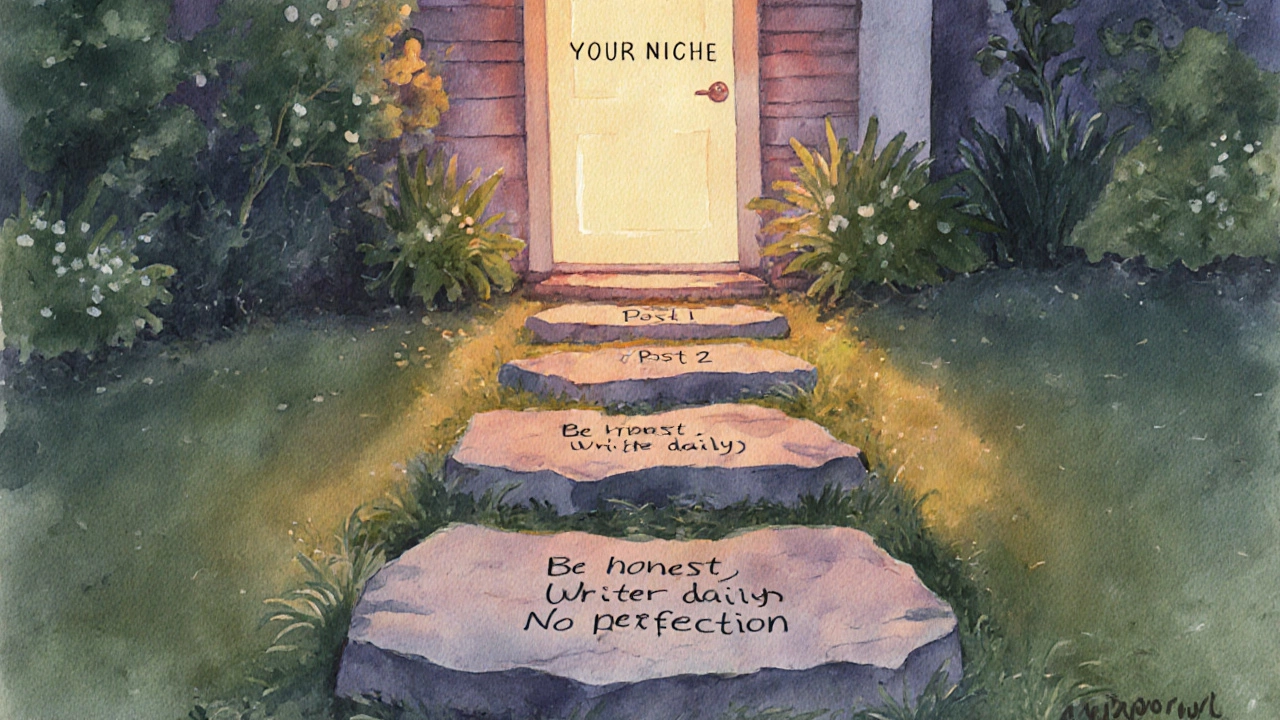Blog Post Length Calculator
Write Your First Post
The article recommends 500-800 words for your first blog post.
Estimated Writing Time
Recommended for your first blog post
If you’ve ever thought about starting a blog but didn’t know where to begin, you’re not alone. Most people get stuck before they even write their first sentence. They worry about being perfect, having a big audience, or needing fancy tools. The truth? You don’t need any of that. All you need is a clear idea and the willingness to hit publish.
Decide what you want to write about
Before you open your laptop, ask yourself: What do I know that someone else needs to hear? It doesn’t have to be something groundbreaking. It just needs to be useful, interesting, or honest.
Think about your daily life. Maybe you’ve figured out how to save money on groceries in Sydney. Or you’ve learned how to grow herbs on a balcony. Maybe you’ve tried five different sleep routines and finally found one that works. These are all blog topics.
Don’t pick something just because it’s popular. Pick something you can talk about for months without getting bored. If you’re not excited about it, your readers won’t be either.
Start with a narrow focus. Instead of "fitness," try "how to stay active with a 9-to-5 job." Instead of "cooking," try "quick meals for parents who get home after 7 PM." Specific topics attract specific readers-and those readers are more likely to stick around.
Choose a simple blogging platform
You don’t need to build a website from scratch. There are tools made for people who just want to write. The two easiest options are WordPress.com and Medium.
WordPress.com gives you full control. You can pick a free theme, add your own domain later, and grow into a real website. It’s what most serious bloggers use. It’s free to start, and you only pay if you want custom features.
Medium is simpler. You sign up, start writing, and your posts show up on a clean, fast site. The downside? You don’t own your audience. If Medium changes its rules, you lose access. But it’s great for testing ideas without any setup.
For beginners, I recommend starting with WordPress.com. It’s free, easy to use, and you can move your content later if you want to switch.
Set up your blog in under 30 minutes
Here’s how to get started on WordPress.com:
- Go to wordpress.com and click "Start Your Website"
- Choose "Blog" as your site type
- Enter a name for your blog (keep it short and clear)
- Pick a free plan
- Sign up with your email
- Choose a simple theme like "Blossom Pin" or "Twenty Twenty-Four"
- Click "Create Site"
That’s it. You now have a live blog. No coding. No hosting headaches. No confusion.
Next, go to "Settings" > "General" and add a short description of your blog. Something like: "Helping busy parents cook simple meals in under 20 minutes." This helps people understand what you’re about.

Write your first post
Your first post doesn’t need to be perfect. It just needs to be real.
Start with a simple title: "How I Finally Got Back Into Running After 5 Years." Or: "The One Habit That Saved My Mornings."
Write like you’re talking to a friend. Don’t use fancy words. Don’t try to sound smart. Say what you mean. If you’re nervous, write it out by hand first. Then type it up.
Keep it short. 500 to 800 words is perfect for your first post. Break it into small paragraphs. Use bullet points if it helps. Add one photo if you can-a picture of your coffee cup, your notebook, your running shoes. People connect with images.
End with a question: "What’s one habit you’ve tried to build? Did it stick?" This invites comments and builds connection.
Hit publish and forget about perfection
The biggest mistake new bloggers make? They wait for the "right time." They think they need more experience, better equipment, or a bigger audience.
Here’s the truth: There is no right time. The only time that matters is now.
Click "Publish." Don’t edit it five more times. Don’t check it on three devices. Just hit publish.
After you do, tell one person. A friend. A family member. Someone who’ll say, "That’s cool!" That small moment of encouragement is more powerful than you think.
Write regularly-even if it’s just once a week
Consistency beats perfection every time.
Set a schedule you can stick to. Once a week. Once every two weeks. Pick a day and time. Monday mornings. Friday evenings. Whatever fits your life.
Don’t aim for long posts. Aim for regular ones. A 400-word post every week is better than a 2,000-word post once a month.
Keep a list of ideas in your phone. When something happens-something funny, frustrating, or surprising-jot it down. "Why my cat hates the vacuum." "The $3 meal that saved my week." Those become blog posts.

Don’t chase traffic yet
Forget about SEO for now. Forget about keywords and backlinks and meta descriptions. Those matter later.
Right now, your job is to build confidence. To find your voice. To learn what feels true to you.
When you start to get comfortable writing, then you can learn how to make your posts easier to find. But don’t let the technical stuff stop you from starting.
What comes next?
After you’ve published five posts, take a step back. Look at them. Which ones felt easiest to write? Which ones got the most feedback? That’s your signal.
You might realize you love writing about budgeting. Or parenting hacks. Or local Sydney walks. That’s your niche. That’s your path.
Don’t rush to monetize. Don’t rush to grow fast. Focus on writing for yourself first. The audience will come when your writing feels honest.
Starting a blog isn’t about becoming famous. It’s about finding out what you think-and sharing it with people who need to hear it.
Do I need to be a good writer to start a blog?
No. You don’t need to be a good writer. You just need to be honest. Most people overthink their writing. They think they need perfect grammar, fancy vocabulary, or a literary style. Real writing is clear, simple, and human. Write like you speak. That’s what people connect with.
How long should my blog posts be?
For beginners, aim for 500 to 800 words. That’s long enough to explain your idea but short enough to finish in one sitting. As you get more comfortable, you can write longer. But don’t force it. Quality matters more than length.
Can I start a blog for free?
Yes. WordPress.com and Medium both let you start for free. You can write, publish, and share without spending a cent. You only pay if you want a custom domain, more storage, or advanced design tools. But those aren’t needed to begin.
What if no one reads my blog?
That’s normal-for the first few months. Most blogs get zero traffic at first. That doesn’t mean you’re failing. It means you’re still learning. Focus on writing for yourself and one person who might benefit. The audience grows slowly, but it grows for real when your writing stays consistent and honest.
How often should I post?
Once a week is ideal for beginners. If that’s too much, once every two weeks works. The goal isn’t to post often-it’s to post regularly. People remember consistency more than volume. Even one good post a month is better than five rushed ones.
Next steps: What to do after your first post
After you hit publish, do three things:
- Save your draft in a notebook or app. Write down what you learned while writing it.
- Share it with one person. Not on social media. Just send it to a friend or family member and ask what they thought.
- Wait a week. Then write your next post. Don’t wait for inspiration. Just sit down and write.
That’s how blogs grow. Not with viral posts. Not with fancy tools. Just by showing up, again and again.



